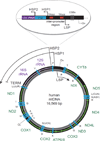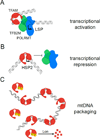Accessorizing the human mitochondrial transcription machinery
- PMID: 23632312
- PMCID: PMC3698603
- DOI: 10.1016/j.tibs.2013.03.006
Accessorizing the human mitochondrial transcription machinery
Abstract
The human genome comprises large chromosomes in the nucleus and mitochondrial DNA (mtDNA) housed in the dynamic mitochondrial network. Human cells contain up to thousands of copies of the double-stranded, circular mtDNA molecule that encodes essential subunits of the oxidative phosphorylation complexes and the rRNAs and tRNAs needed to translate these in the organelle matrix. Transcription of human mtDNA is directed by a single-subunit RNA polymerase, POLRMT, which requires two primary transcription factors, TFB2M (transcription factor B2, mitochondrial) and TFAM (transcription factor A, mitochondrial), to achieve basal regulation of the system. Here, we review recent advances in understanding the structure and function of the primary human transcription machinery and the other factors that facilitate steps in transcription beyond initiation and provide more intricate control over the system.
Copyright © 2013 Elsevier Ltd. All rights reserved.
Figures



References
-
- Bonawitz ND, et al. Initiation and beyond: multiple functions of the human mitochondrial transcription machinery. Mol Cell. 2006;24:813–825. - PubMed
-
- Becker T, et al. Mitochondrial protein import: from transport pathways to an integrated network. Trends Biochem Sci. 2012;37:85–91. - PubMed
-
- Shadel GS, Clayton DA. Mitochondrial DNA maintenance in vertebrates. Annu Rev Biochem. 1997;66:409–435. - PubMed
Publication types
MeSH terms
Substances
Grants and funding
LinkOut - more resources
Full Text Sources
Other Literature Sources

